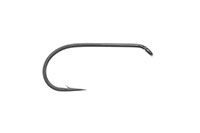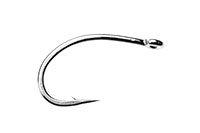
Mountain Streams --Vol.7--
Psychokinesis

It is very useful for every fly fisherman to try to estimate when the fish will come up on the water surface.
If I remember correctly, in the middle of 1970's, psychokinesis became popular among Japanese people. TV shows in which magicians bent a spoon or an iron bar by just touching it, were often on air. Something that was not scientifically proved drew our attention and anglers around me also enjoyed joking around. We said we could fish by psychokinesis. In the Chikuma River and the Noro River, we enjoyed psychokinetic fishing as follows;
Firstly, we pulled ourselves together by striking a certain pose. Then we cast the fly to the point in front of us and watched the fly drifting, saying to ourselves, "Not yet. Wait, wait!" Finally, we cried out, "Now come on, char!" In the next moment the char really jumped at and bit the fly.
Since the fly fishing was not so common at that time, all the anglers were much surprised to see that scene. Not a few of them really believed that we could control fish moving by psychokinesis. But, as you are aware, it was nothing to do with psychokinesis. We merely estimated how the fish were going to move and fortunately guessed right. Anyway, I was surprised to know our estimation proved right so often. I recommend enjoying psychokinetic fishing if you find a good point in the river full of fish. It is very useful for you to estimate exactly when the fish will come up on the water surface from the way of the fly drifting. If you have some practice it will not be difficult to make the fish come up as you predicted and to give your innocent gallery some surprise.

Drifting the fly naturally is the important way for dry fly fishing with success.
Leader for the Dry Fly
In 1985, I at last got the leader that I had wanted for so long. I named it SUPER TECH. Its 7.5ft model had a 1.7ft tippet, 9ft one a 2.3ft tippet and 12ft one a 3.7ft tippet. Those were the first knotless tapered leaders with such long tippet parts in the world. Some technical problems had been an obstacle of its production before. But once Super Tech was completed, I found it much more excellent than I had expected. Nowadays I use this leader for the wet fly, but in those days it was the most advanced dry fly leader. Its concept of design was to control the fly during the casting and to avoid the drag after the fly settled on the water surface. Needless to say, both intentions are two inconsistent ideas. Good control means that the line and the leader can easily affect the fly, which also means that the leader easily causes the drag. On the other hand, the leader that seldom causes the drag, does not affect how the fly drifts or control the fly, either.
When the water is high in spring, we need to make the first cast more carefully.
Thinking about how to break the deadlock, I tried to make the leader with the longest possible tippet that could still keep the good control of the fly. Thus were born three models of the leader with various sizes of tippet above. Fortunately, I could make a great success. By the way, even in the current where the natural drift of the fly seems almost impossible, we often get over the situation by good observation. There is usually the very narrow course of the flow, where we can avoid the drag on condition that we drop the fly at the very particular moment or to the very particular point. If we polish up our casting technique, we will carry the fly to the very delicate point, as if we picked up the fly and put it there. That could avoid the drag although we did not make the tippet part longer than necessary. In other words, those three models aimed firstly at getting good control, whereas avoiding the drag was a little dependent on angler's skill.
But there were limitless desires for better design. Once Super Tech leader was produced, it was considered to be ordinary. Soon I was obliged to design a more advanced leader for the dry fly.

Super Dry Leader made it easy to drifting the dry fly naturally.
Super Dry Leader
It was in Super Tech Leader that we found a point of compromise between good control and drag free casting. Now what can I do to reach more advanced level of compromise? At first, I think over the whole length of the leader. What about making a longer leader than 12ft Super Tech? The fly would definitely be far away from the fly line. It would be useful to lessen the effect of the line on the fly. But if we want to control accurately where the fly settle, we will need some change on this leader design. For example, if we made the leader butt thicker and longer, we would get the good control but apparently cause more drag due to the leader. Except that the current was very plain and simple, that idea would have quite opposite effect of what we had intended. In a small point of an ordinary current we would find such a long leader unmanageable. But if we insisted on making only the tippet part too long, we would not be able to control the fly settling point. Therefore, if we cast the fly in an ordinary sized point in the current, we could not tell where the fly would settle. Most of the wild fish respond to the first fly in the point. So if the first fly settles on the wrong spot, that will spoil everything. Except for dealing with slow-moving fish in the point like a pond, fish in the fishing farm or adult fish just released into the river, we could not get over this contradiction. I longed for a new idea completely different from before, but could not find it soon.
The Noro River in the 1970s. It was fantastic for fishing with dry fly in Summer.
What should we do to carry the fly exactly to the target spot? I remembered the accuracy competition of casting tournament I had enrolled in the first half of 1980's. The accuracy competition, that is the target hitting competition, was what we competed for accuracy by casting the fly to a certain target. At my first entries, I thought that the key factors were to extend the line straight towards the centre of the target and to calculate the distance accurately. Practice made me feel that both were not so difficult to master. I rather realized that it was very important to control the line turn in order to get high marks. Even if I cast the accurate length of line towards the centre of the target, a little disorder of the line turn timing will make the fly settling point completely different. Excessive overturn often caused the leader to hit the target, which led to drop the fly before the target.
Because we used the good control leader in the competition, that problem became all the more serious. In order to solve it I intentionally put the reverse taper in the middle of the leader in order to make the turn performance worse. It was successful.
Can I apply that principle here? When the line makes overturn, the fly settles before the leader. The line tip and the leader settle on the water, slacking off loosely. It takes ages the loose leader to drift and extend. That means the leader does not pull the fly for this long time. Furthermore, when the line and the leader make overturn, the fly, the leader and the line settle on the water at the same time. That is completely different from the situation where the fly is swirling about from the sky without leader turn.

The mountain stream is full of variety. We need to select a good leader for the dry fly.
There is another point to think of. When the line makes overturn, the fly settles on the far nearer point than it does when the leader is fully extended. In other words, making overturn not only avoids drag but also enables the fly to settle on the nearer spot, which means easy control of the fly. I felt as if I could kill several birds with a stone. Can I make a new leader that enables the fly not to settle on the nearer point than the leader after it makes overturn?
It was in spring of 1993 when I tested a new leader. Its butt part was made much thinner than before, which could lessen the load on the line and promote the moderate overturn. In addition, its taper was made sharp so that the line energy was transmitted halfway but stopped in the middle of the leader. I tried to find the perfect length of tippet in order that the fly was not pulled by the leader but carried forward by inertia. After repeated trial and error I found the most suitable design.
The leader I named Super Dry was 12ft long, more than half of which was a tippet part. This was an epoch-making leader for dry fly leader. Although it was 12ft long, the fly settled on almost the same spot as we used 9ft leader. So it was suitable in both large and small fishing points. It needed no special casting technique. Its performance was not spoiled until the tippet part became 1.7ft shorter due to fly change etc.
-- To be continued --
- NET SHOP INFORMATION

SL6 Black Spey Hooks

DU3 Limerick Spinner Hooks

SL4 Single Bartleet Hooks

XD1 Tube Fly Double Hooks

DD2 Flat Perfect Hooks

DD1 Black Terrestrial Hooks

TD4 Old Limerick Wet Hooks

DU1 Silver May Hooks

MU1 Flat Midge Hooks

LD3 Long Limerick Hooks

TD2 Summer Sproat Hooks

XS1 Tube Single Silver Hooks

TD6 Siver Sedge Hooks

SL5 Black Spey Hooks

DU3 Limerick Spinner Hooks
- TROPHY CLUB
- FLY SHOW
- EXHIBITION
- MASTERS`
- FLY DRESSING CONTEST Archives
- TRAVELLER Archives
- TACKLE IMPRESSIONS Archives
- ANGLERS` PHOTO GALLERY Archives
- ----------------------------------------------
- トロフィークラブ
- フライショー
- エキシビション
- マスターズ
- フライドレッシング・コンテスト・アーカイヴ
- トラヴェラー・アーカイヴ
- タックル・インプレッション・アーカイヴ
- アングラーズ・フォトギャラリー・アーカイヴ
株式会社サワダ 185-0021 東京都国分寺市南町3-13-4
SAWADA'S INC. 3-13-4 Minamicho, Kokubunji, Tokyo 185-0021, Japan
写真・ドキュメントの無断転載を禁じます。
All the images and documents found on this site are owned by Ken Sawada and may not be used without permission.
But, link to this site is FREE.
Copyright © 2000 - 2024 SAWADA'S INC.. All rights reserved.
SAWADA'S INC. 3-13-4 Minamicho, Kokubunji, Tokyo 185-0021, Japan
写真・ドキュメントの無断転載を禁じます。
All the images and documents found on this site are owned by Ken Sawada and may not be used without permission.
But, link to this site is FREE.
Copyright © 2000 - 2024 SAWADA'S INC.. All rights reserved.
